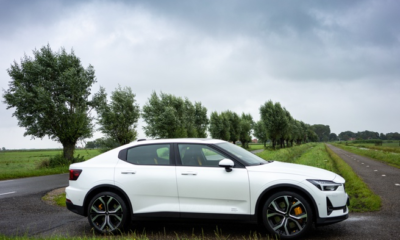NEWS
Mercedes-Benz design Icon Bruno Sacco passes on at 90

The former design chief was responsible for a long list of legends, from the W123 to the G-Class
Born and raised in Italy, Bruno Sacco rose through the ranks at then-Daimler-Benz and eventually set the course for what later became some of Mercedes-Benz‘s most iconic designs. Sacco died on September 19 in Sindelfingen, Germany, at the age of 90.
Sacco was born in Udine, Italy, which is located near the Slovenian border, on November 12, 1933. The son of an Italian infantry battalion commander, Sacco expressed an interest in geometry and machines at a young age.
According to the New York Times, his fascination with cars started in his teens with the 1947 Studebaker Champion Starlight coupe, whose design had aviation-inspired roots.
“It was to have a big impact on my future life,” Sacco told the newspaper in 1998. “It was completely different from anything else at that time, and it turned out to be a very good design.”
Sacco attended the Polytechnic University of Turin, where he earned a degree in mechanical engineering. While at university, he gained experience in automotive model production through projects with established coachbuilder Ghia. After graduation, Sacco continued to work with Ghia and also Pininfarina.
In 1957, Sacco met Karl Wilfert, the head of Mercedes-Benz body testing. Although the two met in Turin, Wilfert was based in Sindelfingen, which was about 400 miles to the north. As it would, Wilfert was creating a new Stylistics department. He already had future design legends Friedrich Geiger at the helm and Paul Bracq as his first auto designer. Within a year, Sacco became his second.
Sacco said that the automaker’s world champion motorsports cars of the mid-‘50s “were 50 percent of the reason he came to Mercedes-Benz,” he told the NY Times. “And the 300 SL Gullwing coupe was the other 50 percent.” The 300SL was designed by Geiger, who was now his boss.
He also confessed that his Sindelfingen stint was intended to be a brief one, perhaps two to three years. What wasn’t on his bingo card was meeting the love of his life in Germany, having a family, and staying put for 40 years.
Sacco first worked in pre-body development and later, in 1970, headed the Body Design and Dimensional Concept department. Under his leadership, the Mercedes-Benz 600 (W100) and the 230 SL “Pagoda” (W113) were developed. Sacco was also instrumental in shaping Wankel-engined concept vehicles like the C111 and C111-II, as well as the hugely successful W123 series.
Five years later, Sacco was named Oberingenieur (chief engineer) and succeed Geiger as head of Stylistics. His first assignment was a wagon version of the W123, which, in 1977, became the automaker’s first-ever station wagon.
Under his tutelage, Mercedes-Benz’s design would became expressive and strong, showcasing both timeless style and modern aerodynamics. A globally-recognized design language was another one of his lasting philosophies. It’s because of Sacco that the Stylistics group was upgraded to a specialist department.
Mercedes-Benz
By the time he retired on March 31, 1999, the Mercedes-Benz lineup had expanded, and Sacco’s design signature had been on every truck, bus, and car produced since 1979. Of course, that list is long, but he was especially proud of the model 126 series of S-Class.
According to the automaker, Sacco once said, “The 126 model series in all design forms is the best thing I have done for Mercedes-Benz.” In fact, in retirement, Sacco had a dark blue 560 SEC in his garage.
Bruno Sacco left an indelible legacy at Mercedes-Benz and with the automotive history as a whole. Sacco received an honorary doctorate from the University of Udine in 2002 and was inducted into the Automotive Hall of Fame (2006) in Dearborn, Michigan, as well as the European Automotive Hall of Fame (2007) in Geneva.
Editor
-

 AVIATION5 years ago
AVIATION5 years agoPhoto News: Air Peace commence flight operations to South Africa
-

 Car News5 years ago
Car News5 years agoPolestar is recalls over 2000 electric cars due to software bug
-

 RAIL5 years ago
RAIL5 years ago36 Killed in Pakistan Train Accident
-

 Technology5 years ago
Technology5 years agoCommon mistakes in CO₂ emissions calculations
-

 Business5 years ago
Business5 years ago2016 Volvo XC60 review and specifications
-

 Reviews5 years ago
Reviews5 years ago2021 Audi A6 Specifications and Review
-

 SAFETY / CAR CARE5 years ago
SAFETY / CAR CARE5 years agoHandbrake warning light; what it means and what to do
-

 Reviews3 years ago
Reviews3 years agoDebutant Kia’s new K8 sedan benchmarks luxury, safety
